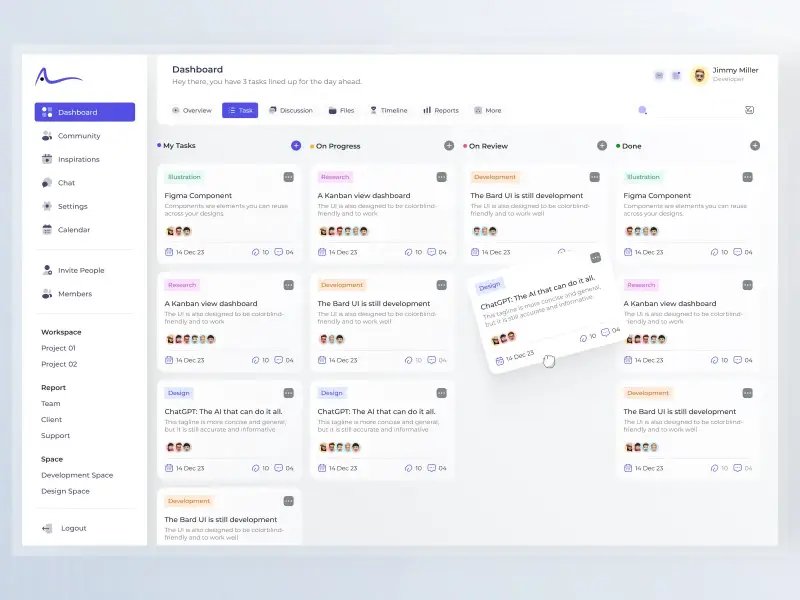The Ultimate Guide to Scaling Remote Software Development Teams
- TECHVIFY Team
- 0 Comments
Remote work isn’t just a trend, it’s the future. Even before the pandemic, professionals everywhere craved flexibility and less time spent commuting. Yet, despite successful examples from companies like Facebook and Spotify, many businesses still hesitate to embrace remote software development teams.
There’s a lingering skepticism, especially when it comes to outsourcing. Some assume it’s only good for small tasks or MVPs, not for building high-quality products. But that’s far from the truth.
At TECHVIFY, we’ve seen this firsthand. When clients first consider a remote development team, they often have doubts. But once they experience the talent, efficiency, and seamless collaboration, that hesitation turns into confidence. Managing remote software developers isn’t just possible, it’s a game-changer for scaling businesses.
Let’s break down the myths and explore how the right remote dedicated software development team can transform the way you build software.
The Transformative Impact of Remote Work on Software Development
The software development industry has always been well-suited for remote collaboration, but the global shift to distributed work has permanently reshaped how teams operate. While the pandemic accelerated this transition, the lasting appeal of remote and hybrid models stems from their undeniable benefits, along with some unique challenges to navigate.
Remote development team
Why Remote Software Development Teams Thrive
Distributed work unlocks unprecedented opportunities for both companies and developers:
-
Global talent access – Build your dream team without geographical constraints, sourcing top developers worldwide
-
Extended productivity windows – Leverage time zone differences to maintain near-24/7 development cycles
-
Focused work environments – Async-first communication reduces interruptions, enabling deeper concentration
-
Improved quality of life – Flexible schedules help developers achieve better work-life integration
Challenges to Proactively Address
While powerful, remote work isn’t without hurdles:
-
Real-time collaboration gaps – The absence of spontaneous face-to-face interactions requires intentional communication strategies
-
Time zone complexity – Coordinating across multiple regions demands careful planning for meetings and deadlines
-
Tech setup variability – Ensuring consistent development environments across distributed teams takes extra effort
-
Cultural cohesion – Building team unity requires creative alternatives to traditional office bonding
The most successful teams don’t just adapt to remote work—they redesign their workflows to capitalize on its strengths while mitigating the challenges. By implementing the right tools, processes, and cultural approaches, distributed software teams can achieve remarkable results.
Learn More On:
10 Tips to Successfully Manage a Remote Software Team
Managing a remote team comes with its own set of challenges—but also incredible opportunities. You might wonder:
-
What are the biggest hurdles when working with remote developers?
-
Should we use monitoring software?
-
How do we keep productivity high across different time zones?
These questions matter because remote work isn’t just “office work from home”—it’s a whole different experience. The good news? With the right approach, your remote software development team can be just as effective (if not more) than an in-house one.
Here’s how to make it work:
1. Understand How Remote Teams Operate
Remote teams aren’t just dispersed—they’re diverse. Your developers could be in different cities, countries, or even continents. This setup brings huge benefits (like cost savings and access to global talent) but also unique challenges—especially in communication.
The key? Proactive collaboration. With the right tools and mindset, even time zone differences and async workflows become manageable.
2. Hire the Right People (Not Just the Best Coders)
A great remote development team isn’t just about technical skills—it’s about communication, independence, and adaptability.
-
Look for proven remote experience – Have they worked remotely before? Do they thrive in a self-driven environment?
-
Prioritize clear communicators – Remote work lives and dies by Slack, Zoom, and emails. Your team must express ideas clearly and proactively.
-
Cultural fit matters – If you’re extending an offshore development team, ensure work styles align to avoid friction.
At TECHVIFY, we’ve seen clients succeed by focusing on these traits, not just resumes.
Remote dedicated software development teams
3. Streamline Remote Onboarding
Effective onboarding sets the tone for your remote software development team. Focus on cultural integration through virtual meetups and clear documentation of workflows. Assign mentors to help new hires navigate processes and feel connected. Provide structured resources about your codebase, tools, and communication expectations. This approach ensures your remote development team members become productive faster while feeling valued from day one. Remember, good onboarding reduces early friction in distributed teams.
4. Optimize Work Processes
Clear processes are vital when managing remote software developers. Define workflows for task assignment, progress tracking, and issue resolution using tools like Jira. Build in flexibility for time zones while maintaining accountability through regular check-ins. Schedule retrospectives to continuously improve collaboration. Your remote dedicated software development team will thrive with structure that balances organization with autonomy, focusing on results rather than rigid schedules.
Looking to Outsource Development?
Contact TECHVIFY, Vietnam’s Leading Offshore Software Development & Outsourcing Company, for consultation and development services.
5. Master Remote Communication
Successful remote development teams prioritize intentional communication. Establish core collaboration hours for real-time discussions while allowing async work. Use Slack for quick questions, Zoom for meetings, and email for detailed updates. When hiring, value both technical skills and communication ability. Over-communicate initially to build understanding – it’s better to repeat than to confuse. These practices keep your distributed team aligned and productive.
6. Make One-on-Ones Count
Regular one-on-one meetings are the heartbeat of managing remote software developers effectively. These private check-ins create space for meaningful conversations about progress, challenges, and professional growth. Focus on setting SMART goals together and reviewing achievements rather than dwelling on shortcomings. This approach builds trust while keeping your remote development team aligned and accountable.
Schedule these meetings consistently – whether weekly or biweekly – to maintain strong connections despite the distance. Remember to actively listen and provide constructive feedback. These personal touchpoints often reveal insights that team meetings miss, helping you support each developer’s unique needs while keeping everyone moving toward shared objectives.
7. Power Up with Pair Programming
Pair programming transforms how your remote software development team collaborates and learns. By pairing developers – especially mixing senior and junior talent – you create real-time knowledge sharing that improves code quality and speeds up problem-solving. Schedule regular sessions during overlapping work hours, using screen-sharing tools for seamless collaboration. This practice not only catches errors early but also fosters mentorship and team bonding.
Encourage pairs to switch roles between “driver” and “navigator” to maximize learning. While it requires some scheduling flexibility across time zones, the investment pays off in stronger skills, better solutions, and a more cohesive remote development team. Track the impact through code review metrics and team feedback to refine your approach.
8. Build Bridges Through Bonding
Virtual team building is essential for remote teams to thrive beyond task completion. Create dedicated spaces and times for informal connections – like weekly virtual coffee chats or monthly game nights. Introduce fun Slack channels for sharing memes, pet photos, or personal wins. These moments of levity build camaraderie that translates into better work collaboration. For your offshore development team, be mindful of cultural differences when planning activities to ensure inclusivity.
Even simple practices like starting meetings with personal check-ins or celebrating birthdays virtually can strengthen relationships. The goal isn’t forced fun, but authentic opportunities to connect as people first, colleagues second. This investment in team culture pays dividends in retention and collaboration quality.
Managing remote software developers
9. Optimize Project Management Tools
Selecting the right project management software is crucial for your remote software development team’s success. The ideal tools should streamline workflows while keeping communication and documentation organized. While teams often have existing preferences, take time to evaluate options that best suit your remote development team’s needs. Invest in robust solutions for task tracking (like Jira) and communication (like Slack) – cutting corners here leads to frustration.
For managing remote software developers effectively, ensure your toolstack includes: 1) Clear task management, 2) Seamless file sharing, and 3) Integrated communication channels. Remember, the goal is to reduce friction, not add complexity. At TECHVIFY, we’ve found that combining specialized tools for different functions works better than seeking a single perfect solution.
10. Balance Communication Modes
Effective remote dedicated software development teams master the art of balanced communication. Use real-time methods (video calls, instant messaging) for collaborative problem-solving and urgent matters, while reserving asynchronous channels (email, documentation) for updates and non-critical discussions. When managing remote software developers, establish clear guidelines: “If it can be an email, don’t schedule a meeting.” This prevents video fatigue while maintaining productivity.
Encourage your remote development team to:
1) Default to async first, 2) Document decisions thoroughly, and 3) Respect focus time.
The sweet spot emerges when team members feel connected without being constantly interrupted. Remember, over-communication beats ambiguity in remote settings, but the right balance prevents burnout and keeps your team operating at peak efficiency.
Learn More On:
Security in Distributed Software Development
Remote software teams face unique security challenges that demand proactive solutions. Without physical access to devices, companies must implement:
-
Endpoint protection – Deploy remote monitoring tools to secure all devices
-
Automated compliance – Use systems that enforce patches and configuration standards
-
Access controls – Require VPNs and multi-factor authentication for all systems
Navigating Global Compliance
Expanding your team internationally introduces complex regulations. Your legal team should handle specifics, but technical leaders must understand key requirements like data sovereignty laws and industry certifications. Standardized security onboarding and regular training help maintain compliance across borders.
Building a Security-First Culture
Effective remote teams bake security into their workflows. Start with clear acceptable use policies and incident response plans tailored for distributed work. Regular phishing tests and security awareness programs keep protection top of mind for all team members, regardless of location.
Conclusion
Managing a remote software development team comes with unique challenges—but also game-changing benefits. From optimizing communication to ensuring security, the right strategies can transform your distributed team into a high-performing powerhouse. The key? Combining the right tools, clear processes, and a culture of trust.
Ready to build or scale your remote software development team with confidence? TECHVIFY delivers top-tier talent and proven management strategies—tailored to your needs. Get a free consultation today and let’s turn remote work into your competitive advantage.
TECHVIFY – Global AI & Software Solution Company
From Startups to Industry Leaders: TECHVIFY prioritizes results, not just deliverables. Accelerate your time to market and see ROI early with high-performing teams, AI (including GenAI) Software Solutions, and ODC (Offshore Development Center) services.
- Email: [email protected]
- Phone: (+84)24.77762.666










